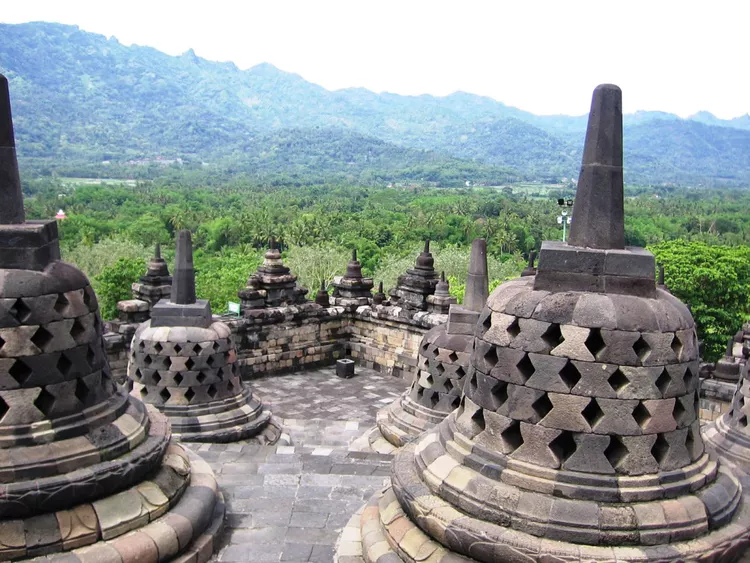Summary
Borobudur is a giant Mahayana Buddhist monument in Central Java. Built in AD 800, the monument was lost for hundreds of years following the decline of the Buddhist kingdoms in Java. Borobudur was rediscovered in the 19th century, rescued from the surrounding jungles, and today is a major Buddhist pilgrimage site.
Borobudur is built on a stupendous scale — it couldn’t be otherwise, as it is nothing less than a representation of the cosmos as Buddhist theology understands it.
Once you enter Borobudur, you find yourself being led into an intricate cosmology immortalized in stone, which is a magnificent trip for amateur archaeologists, albeit one that will require an experienced guide to decipher.
Structure of Borobudur
The monument is shaped like a mandala, forming a series of platforms — five square platforms below, four circular platforms above — riddled with a pathway that takes pilgrims through three levels of Buddhist cosmology.
Visitors ascend steep stairs to each level; the walkways are ornately decorated with 2,672 relief panels that narrate stories from the Buddha’s life and significant parables from Buddhist texts.
To view the reliefs in their proper order, you should start from the east gate, circulating clockwise then climbing one level up as you complete a circuit.
Levels of Borobudur
The lowest level of Borobudur represents Kamadhatu (the world of desire), and is adorned with 160 reliefs depicting stark scenes of human desire and their karmic consequences. These illustrations are intended to inspire the pilgrim to seek liberation from earthly attachments and attain Nirvana.
Interestingly, the lowest platform showcases only a fraction of the reliefs; much of its lower section is buttressed with additional stonework, hiding some of the reliefs. Our guide hinted that certain more provocative reliefs were intentionally obscured, although there’s no concrete evidence to support this.
As visitors ascend towards Rupadhatu (the world of forms, consisting of the next five levels), the reliefs gradually transition to depicting the miraculous story of the Buddha’s conception and birth. They also illustrate heroic deeds and important parables from Buddhist folklore.
Upon reaching Arupadhatu (the world of formlessness, represented by the four top levels of Borobudur), visitors will encounter perforated stupas housing Buddha statues. Unlike the first four platforms, bordered on both sides with stone, the upper four levels are open, offering expansive views of the Magelang regency and Merapi volcano in the distance.
At the pinnacle, a central stupa crowns Borobudur. Average visitors are generally not permitted to enter the stupa, not that there’s anything visible inside — it is empty, symbolizing the escape to Nirvana or nothingness, the ultimate goal of Buddhism.
Buddha Statues at Borobudur
The Buddha statues on the lower four levels of Borobudur are positioned in various “attitudes” or mudra, each referencing an event in the Buddha’s life.
- Bhumi Sparsa Mudra: the “seal of touching the earth”, depicted by the Buddha statues on the east side — left hands laid open on their laps, right hand on right knee with fingers pointing downward, referencing the Buddha’s struggle against the demon Mara.
- Vara Mudra: representing “charity”, shown by the Buddha statues on the south side — right hand held palm up with fingers on right knee, left hand laid open on lap.
- Dhyana Mudra: representing “meditation”, displayed by the Buddha statues on the west side — both hands resting on lap, right hand atop left, palms facing up, two thumbs meeting.
- Abhaya Mudra: representing reassurance and fearlessness, presented by the Buddha statues on the north side — left hand laid open on lap, right hand raised slightly above knee with palm facing front.
- Vitarka Mudra: representing “preaching”, portrayed by Buddhas on the balustrade of the top square terrace — right hand raised, thumb and forefinger touching, symbolizing the act of preaching.
The Buddha statues on the higher levels are enclosed within perforated stupas; one statuette is intentionally left incomplete to reveal the Buddha inside. There’s another statue believed to bring good luck if touched; however, accomplishing this is trickier than it appears as you cannot see the statue once you reach in.
Waisak at Borobudur
Every year, many Buddhists flock to Borobudur during Waisak, the Buddhist day of enlightenment. On this special day, hundreds of monks from Indonesia and beyond commence a solemn procession from nearby Candi Mendut at 2 a.m., walking the 1.5 miles to Borobudur.
This procession is slow-paced, filled with chanting and prayers, as they make their way to Borobudur, arriving around 4:00 a.m. The monks then circumambulate the temple, climbing the levels in proper order, awaiting the moon’s appearance on the horizon (which signifies the birth of the Buddha). They greet the moon with a song, concluding their ceremonies after sunrise.
Getting to Borobudur
To find ticket office hours and the entrance fee, check Borobodur’s website. The nearest convenient airport is in Yogyakarta, approximately 40 minutes away by car.
By bus: Head to the Jombor bus terminal in Sleman, north of Yogyakarta; buses frequently run between the city and the Borobudur bus terminal. The fare is around IDR 20,000 (approximately $1.60), making for a one to one-and-a-half hour journey. The temple is just a 5 to 7 minutes’ walk from the bus terminal.
By hired minibus: This option is the most convenient way to arrive at Borobudur, though not the most budget-friendly. Consult your Yogyakarta hotel for recommended minibus tour packages. Prices may vary from IDR 70,000 to IDR 200,000 (between $5.60 and $16), depending on the inclusions of the package (such as side trips to Prambanan or local factories).
Consider taking a Borobudur Sunrise Tour, which allows you to visit the temple at the early hour of 4:30 a.m., providing an opportunity to experience the temple by flashlight until the sunrise. For more details on fees, visit the website.





